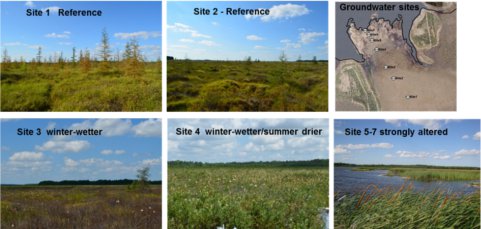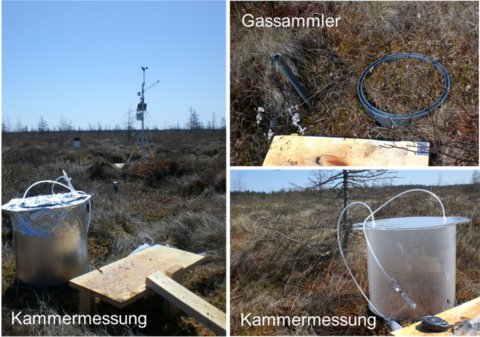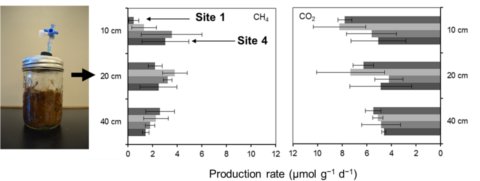Trace gas emission from peatlands
Impact of long-term wetting on carbon cycling and climate change feedback in a northern temperate bog (Ontario, Canada)

Background
Northern peatlands represent an important global carbon stock and source of methane to the atmosphere. The fate of carbon in these environments under changed climatic conditions is thus of considerable scientific importance. Our knowledge of future peatland carbon cycling is deficient with respect to the effects of future wetter conditions, both by climate change and by changes in runoff networks surrounding peatlands. We address this research gap at Luther Bog (Ontario), which represents a northern ombrotropic bog complex that, in one area, has undergone long-term wetter soil conditions due to construction of a reservoir in 1952 and developed strong ecological and ecohydrological changes since.
Preliminary work demonstrated that the long-term effects of 60 years of (a) winter-wetter and (b) winter-wetter and summer-drier soil moisture conditions can be studied against two reference sites of similar water table dynamics, yet different vegetation and soil temperatures. To identify the impact of these relevant climate change scenarios on carbon cycling is the project’s overarching objective.
Specifically, the project will- establish an atmospheric carbon balance in four areas of differing climate change analogues and quantify the effect on C fluxes, C sequestration and greenhouse warming potentials (GWP),
- identify the impact of the changed soil hydrologic regime on in vitro and in situ peat decomposition and the chemical quality of the formed peat,
- identify changes in the distribution between soil microbial and plant-derived respiration as these are differentially dependent on climatic drivers,
- determine differences in the temperature dependency soil microbial and plant-derived respiration under background and wetter soil moisture regime,
Apart from closing an important empirical research deficiency, the project will provide an empirical basis for ecosystem modeling efforts that will generalize the response of peatlands to wetter conditions and allow for the testing of climate change scenarios. The overall hypothesis to be tested is that (I) wetter conditions will lead to increased carbon sequestration due to slowing of soil respiration and (II) to enhanced methane emissions due to less methane oxidation and establishment of plant communities adapted to wet conditions. We further hypothesize that the effect of additional methane emissions will outweigh that of carbon sequestration on a 100-year time scale. We also expect that more poorly decomposed and highly permeable peat accumulates that has a high potential for CO2 emissions under oxic conditions and a more pronounced seasonal dynamics of carbon fluxes. The aggrading peat masses would thus be much more instable against future changes in hydrologic boundary conditions.


Methods
The project relies on a broad range of methods that encompasses both field and laboratory techniques. The investigations primarily focus on four areas within the Luther Marsh / Wylde Lake Bog complex that differ in terms of their long-term hydrologic regime due to their proximity to Luther Lake reservoir.
One methodological focus of the investigations is the quantification of carbon dioxide and methane exchange with the atmosphere using chamber approaches and modern gas analytics using a Los Gatos Ultraportable Greenhouse Gas Analyzer coupled to a multi-port system. These measurements are conducted in 12 locations at the four intensively investigated sites. Additional measurements are conducted at Luther Lake shore and Wylde Lake using floating chambers and gradient methods. Soil gas concentrations are determined with soil gas samplers and gaschromatography and soil physical data acquired using FDR soil moisture (Function Domain Reflectory, ECH2O EC-5, Decagon Devices) and temperature sensors (TMC6-HD, HOBO in several soil depths. Atmospheric conditions are monitored (temperature, photosynthetically active radiation, humidity, wind speed) using a weather station on-site.
To investigate shifts in the balance between aerobic and anaerobic respiration, methane production and methane emission and their influence on emissions we employ 13C analysis of CO2, CH4 and DOC of soil and emitted gas. For this purpose a CRDS Analyzer for isotopic composition in CO2 and CH4 is available (PICARRO, G2201-i. ) that is coupled to a TOC analyzer. To determine shifts in activity and distribution of roots along the hydrological-plant community gradient we use 13C marker experiments.Differences in the decomposability of the organic carbon along the transect and within sites are analyzed using classical incubation approaches. Such information is related to chemical quality of the peat as determined with infrared and fluorescence spectroscopy.
Mass balance and mechanistic approaches are complemented by a remote sensing approach that quantifies the spatial distribution of vegetation and morphological units within the peatland using infrared imaging and GIS. This approach ultimately aims at scaling up carbon fluxes.
By coupling mass balance and mechanistic approaches we aim for establishing links between processes and fluxes and thus improve the confidence in generalizations of the results.
Students
In summer 2014 two M.Sc. and one B.Sc. students will conduct their thesis research at the Luther Bog site. These theses will address a) the decomposability and chemical differences in decomposability along the vegetation gradient (M.Sc. candidate Marie Goebel and B.Sc. candidate Cornelia Mesmer) and the quantification of gas exchange and carbon turnover in the adjacent aquatic systems of Wylde Lake and Luther Lake (M.Sc. candidate Magdalena Burger).
In summer 2014 and 2015 there are further possibilities to do undergraduate and graduate research at the site. Possible research topics are:- Mapping of vegetation patterns and biomass as well as the contents of nutrient elements in selected plants and its analysis using remote sensing and GIS
- The analysis of micro-topography on the nature and decomposability of organic matter
- The analysis of changes in root activity and distribution along the transect using 13C isotope experiments and soil gas analysis
- The analysis of soil water and groundwater flow patterns
Further information is provided by Prof. Dr. Christian Blodau and Dr. Sina Berger.
Info
Project partners and contact
University of Muenster
Institute of Landscape Ecology, Hydrology Group
Principal Investigator: Prof. Dr. Christian Blodau
Postdoctoral scientist: Dr. Sina Berger
University of Guelph
School of Environmental Sciences
Prof. Dr. Claudia Wagner-Riddle
Luther MarshFunding: German Science Foundation (DFG)
Project period: 10/2013 – 09/2016News
Instrumentation: In October/November 2013 the site Luther Bog was instrumented with boardwalks and platforms to conduct the gas flux measurements (see also images).
Conference: In July 2013 we presented results from preliminary hydrological and biogeochemical investigations under the title “Impact of long-term flooding on the hydrology and biogeochemistry of a northern bog in Ontario, Canada“ at the SEFS Symposium for European Freshwater Sciences in Münster.
Images


